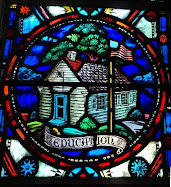by Virginia Knowles
I personally think poetry is sadly neglected by many home schoolers. What a loss! Beyond the beautiful words, poetry can communicate important ideas to inspire and influence society. Since our culture values tolerance toward all forms of artistic expression, poetry can often reach hearts that prose cannot. I encourage you to incorporate poetry into your lives and home schools in many ways:
Find a poem that you would like to share with your children. Jot it down, memorize it, read it out loud, and post it on the wall!
Make a collection of good poetry available in your home. Many home school catalogs carry poetry anthologies, such as:
- Favorite Poems Old and New edited by Helen Ferris
- The Book of Virtues edited by Dr. William Bennett. (Edgar Guest is my favorite poet!)
Keep poetry sessions short, simple and fun. Beginning students have short attention spans and can’t always handle abstract ideas, so start with nursery rhymes and humorous verse. “Over in the Meadow,” a popular children’s rhyme often found in poetry anthologies or as a separate book, introduces numbers, animals and repetition. There are many charming Christian versions of Mother Goose.
Read a poem out loud with an expressive voice. Savor the sounds and cadences as they roll off your tongue. (I love alliteration: the busy bumble bee and the hive of honey.) Have your children each choose a poem to memorize and recite for a special family occasion or open house, just as students did in the one-room schools.
Notice the rhyming pattern of a poem. “One two, buckle my shoe. Three, four, shut the door” is an example of an AABB pattern. The first two lines rhyme, and then the last two rhyme.
Clap out a rhythm pattern. “Mary had a little lamb” is DUM de DUM de DUM de DUM, and is written in the “trochee feet” rhythm.
Find poetry related to whatever theme you are studying.
- Forest: “Stopping by Woods on a Snowy Evening” by Robert Frost
- Seasons: “Bed in Summer” by Robert Louis Stevenson
- The American Revolution: “Paul Revere’s Ride” by Henry Wadsworth Longfellow
- Japan: haiku
Copy and illustrate a poem. Use markers, colored pencils or your computer’s painting program. Add a decorative border. Hang it on the wall or give it to the grandparents.
Let each person try writing a poem to describe a familiar object or experience. What do you hear, see, feel, smell, and/or taste? Or, try to express your feelings and beliefs. Write a poem to commemorate a special person or occasion. It will be a cherished gift!
Have a poetry tea time. Kelly-Ann Gritner-Gibbons in Canada shares, “At our home we have tea-time with poetry reading. I make Cambric Tea using decaffeinated Orange Pekoe tea, sugar and milk - mostly milk! My daughter and I take turns choosing poetry to read. I read her selections for her right now. (We have been reading selections from The Complete Book of the Flower Fairies by Cicely Mary Barker.) Or I choose one poetry book and we read aloud every poem we come across. (Robert Louis Stevenson's A Child's Garden of Verses is good; we have the one illustrated by Tasha Tudor.) After we have finished reading some poetry, we enjoy one or two snacks. Sometimes we do this in our kitchen, using real tea cups, while other times we do this outside, sitting on a blanket. We have poetry and tea time at least once a week - and sometimes seven times in a week - upon my daughter's request!”
~*~
This article is a short excerpt from my book Common Sense Excellence: Faith-Filled Home Education for Preschool to 5th Grade.

















Virginia,
ReplyDeleteI couldn't resist commenting...Edgar Guest is my favorite poet, too. In fact, he is a cousin! (My mother's maiden name was Guest.) I've collected most of his books.
I'm loving everything I see on your site, especially the books/lit suggestions. It's rare for me to find a list that includes something new to me that I consider to be worthwhile.
I'm linking my blog to yours...hope you'll check mine out. I've posted a short list of my favorite picture books.
Blessings,
Susan Lemons www.susanlemons.wordpress.com